
HPU2. Nat. Sci. Tech. Vol 02, issue 02 (2023), 03-10
HPU2 Journal of Sciences:
Natural Sciences and Technology
journal homepage: https://sj.hpu2.edu.vn
Article type: Research article
Received date: 28-6-2023 ; Revised date: 26-7-2023 ; Accepted date: 15-8-2023
This is licensed under the CC BY-NC-ND 4.0
On the second Hilbert coefficients and Cohen-Macaulay rings
Van-Kien Do
a,*
, Khanh-Linh Ha
b
,
Dai-Tan Tran
c
, Ngoc-Yen Hoang
b
a
Department of Mathematics, Hanoi Pedagogical University 2, 32 Nguyen Van Linh, Phuc Yen, Vinh Phuc,
Vietnam.
b
Department of Mathematics, Thai Nguyen University of education, 20 Luong Ngoc Quyen, Thai Nguyen City,
Thai Nguyen, Vietnam.
c
Institute of Mathematics, VAST, 18 Hoang Quoc Viet, 10307 Hanoi, Viet Nam
Abstract
In this paper, we investigate the relationship between second Hilbert coeficients and the index of
reducibility of parameter ideals. We give some characterazations of Cohen-Macaulay rings via the
above invariants.
Keywords: Cohen-Macaulay ring; Approximatetly Cohen-Macaulay ring; Hilbert coefficient;
Multiplicity.
1. Introduction
Let
( , )R
m be a commutative Noetherian local ring of dimension d, where
m
is the maximal
ideal. Let I be an
m
-primary ideal of R. It is well-known that there are integers
,
i
e I R
, called the
Hilbert coefficients of R with respect to I, such that
0 1
1
1
( ) ( , ) ( , ) ( 1) ( , )
1
d
R d
n
n d n d
Re I R e I R I R
Ie
dd
for all
0n
. Here
( )
R
N
denotes the length of an R-module N. The leading coefficient
0
,e I R
is
called the multiplicity of R with respect to I, and
1
,e I R
is named by W.V. Vasconcelos ([18]) as the
Chern number of R with respect to I.
* Corresponding author, E-mail: dovankien@hpu2.edu.vn
https://doi.org/10.56764/hpu2.jos.2023.2.2.3-10

HPU2. Nat. Sci. Tech. 2023, 2(2), 03-10
https://sj.hpu2.edu.vn 4
The multiplicity and the Chern number of R with respect to parameter ideals can be used to
deduce a lot of information on the structure of some classes of rings/modules, such as Gorenstein rings
by Nagata [9]; Cohen-Macaulay modules by L. Ghezzi et al., W.V. Vasconcelos in [6, 18];
Buchsbaum modules by J. Stuckrad and W. Vogel in [13]; generalized Cohen-Macaulay modules by
S. Goto et al. in [7].
Let M be a finitely generated module over a Noetherian ring R. A proper submodule N of M is
called an irreducible submodule if N can not be written as an intersection of two properly larger
submodules of M. In 1921, E. Noether [10] showed that every submodule N of M can be expressed as
a finite intersection of irreducible submodule. Futhermore, the number of irreducible components of
an irredundant irreducible decomposition of N, which is independent of the choice of the
decomposition, is called the index of reducibility of N. Now our motivation stems from the work of the
results of H.L. Truong et al. (see [11, 12, 14]) which demonstrate that reveals an interesting
correlation between the Hilbert coefficients and the index of reducibility. The aim of our present work
is to continue this research direction. Concretely, we will give some of characterizations of a Cohen-
Macaulay rings in terms of the second Hilbert coefficients and the index of reducibility with respect to
parameter ideals.
2. On the second Hilbert coefficients and Cohen-Macaulay ring
In what follows, throughout this paper, let
( , , )
R k
m
be a Noetherian local ring of dimension d,
where
m
is the maximal ideal and
R
k=
m
is the residue field of R. Suppose that R is a
homomorphic image of a Cohen-Macaulay local ring. Let M be a non-zero finitely generated R-
module of dimension s.
Let I be an ideal of R such that
M
IM
has the finite length. Samuel showed that there is a
polynomial
( )
I
P M
of degree s with rational coefficients such that 1
( )
R I
Mn
I M
P
M
with n large
enough, where
( )
R
N
denotes the length of an R-module N. This implies that there are integers
,
i
e I M
, called the Hilbert coefficients of M with respect to I, such that
0 1
1
1
( , ) ( , ) ( 1) ( , ) (2.1)
1
s
R s
n
n s n s
Me I M e I M I M
s
Ie
Ms
for all
0
n
. The Hilbert coefficients are used to measure the complexity of the structure of the
module M. We call the leading coefficient
0
,
e I M
the multiplicity of M with respect to I, and
1
,
e I M
is said to be the Chern number of M with respect to I.
Definition 2.1 (see [8]). The depth of M, denoted by
depth
M
, is defined to be the greatest
integer t such that
H ( ) (0)
iM
m
for all
i t
. We say that M is a Cohen-Macaulay module if
idepth d m
M M
, i.e.,
H ( ) (0)
iM
m
for all
dim .
i M
In particular, if R is a Cohen-Macaulay R-
module then R is said to be a Cohen-Macaulay ring.
Definition 2.2 (see [2]). We say that M is a generalized Cohen- Macaulay module if
H ( )
R
iM
m for all
0 1
i s
.

HPU2. Nat. Sci. Tech. 2023, 2(2)
,
03-10
https://sj.hpu2.edu.vn 5
By the definitions, every Cohen-Macaulay module is a generalized Cohen- Macaulay module.
The following assertion is due to [8] which gives a sufficient and necessary condition for R to be a
Cohen-Macaulay ring in terms of the equality (2.1). Here we include an independent proof.
Theorem 2.3. Let
1 2
( , ,..., )
d
q a a a
be a parameter ideal of R. Then there are inequalities
1
0
( , ) ( ) ( )
n
R R
n d n d
R
e q R qd
Rq
d
for all
0n
. The above inequalities become equalities if and only if R is a Cohen-Macaulay ring.
When this is the case, we have 𝑒
(𝑞, 𝑅)= 0, for all 𝑖 = 1, … , 𝑑.
Proof. Let
( )I
denote the minimal number of generators of an ideal I of R. The upper bound for
1
( )
n
R
Rq
follows from the fact that
1
0 0
0
1
( )
1
1
.
(
( ) ( ) ( )
)
( )
n n
n
R R R
i i
ii
n
R
i
R
i
Rq
d i
d
n d
I
qR
q
Rq
R
d
q
q
For the rest of inequality, we let
1 2
[ , ,..., ]
d
S R X X X
is the polynomial ring and let
1 2
( , ,..., )
d
S X X X
m
in S. Let
, 1
i i i
f X a i d
and put
1 2
( , ,..., )
d
f f f S
q
. Then
1 2
, ,...,
d
f f f
is a regular sequence in S, as
1 2
[ , ,..., ]
d
S R f f f
. We look at the homomorphism
:S R
defined by
( )
i i
X a
for all . Then
Ker
q. We put
C S
and extend
to
the homomorphism
:C R
Then
Ker C
q and we have the following identifications
1 1 1
1 2 1 2
/ ( , ,/ , ) / ( , , , )
n n n
d d
B X X X C C XR X X C
q q q
for all
0n
, whence
1 2
, ,...,
d
X X X
is a system of parameters for
1n
CC
q
. Let
Then, thanks to the associative formula of multiplicity together with the fact that
1 2
, ,...,
d
f f f
is a
regular sequence in C, we get
1 1
1
20
2
1
1
( / ) ( , , ,
,
/ [ )
( , , ) ,
]
/
n n
R d
n
d
C
R C X X X C
X X X C C
C
e C
q q
q

HPU2. Nat. Sci. Tech. 2023, 2(2)
,
03-10
https://sj.hpu2.edu.vn 6
0
( , )
n d e R
d
q
for all
0n
. Let
0n
be now a fixed integer. We then have
1
0
( / ) ( , )
n
R
n d
R e R
d
q q
if and only if
which is equivalent to saying that
1n
CC
q
is a Cohen-Macaulay local ring. Since
1n
C
q
is a perfect
ideal of C (recall that
1 2
( , ,..., )
d
f f f
q
is generated by a S-regular sequence
1 2
, ,...,
d
f f f
), this
condition is equivalent to saying that the local ring C is Cohen-Macaulay, which means our base ring
R is Cohen-Macaulay.
The problem we are interested in now is we need the following notion that how to characterize
the structure of M in terms of its Hilbert coefficients, such as investigating the Hilbert coefficients of
M so that M is a Cohen-Macaulay module. For this purpose, we need the following notion. A proper
submodule N of M is called irreducible if it can not be written as an intersection of two strictly larger
submodules of M. For a submodule N of M, the number of irreducible components of an irredundant
irreducible decomposition of N, which is independent of the choice of the decomposition, is called the
index of reducibility of N and denoted by
ir
M
N
(see [10]). For a parameter ideal
q
for M, we have
ir ir :
( ) : ( )
M
M M R
M
MM
[q m]
q q q.
We further set
0
I( , ) ( / ) ( , )M M M e M
q q q
. Note that, by Theorem 2.3,
I( , )M
q is always
non-negative. Let
I( ) sup ( , ) ,IM M
q
q
where
q
runs over all systems of parameters of M.
We summarize a way to compute the invariants introduced above. Let
( ) (H ( ))
i
i R
h M M
m
and
H ( )
( ) (0) :
i
iM
r M
m
m for
1, ,i s
.
Lemma 2.4 (see [9, Corollary 3.2] and [3, Theorem 1.1]). Suppose that R is a generalized
Cohen-Macaulay ring with
dim 0d R
and
q
a parameter ideal of R contained in n
m for
0n
.
Then the followings hold true.

HPU2. Nat. Sci. Tech. 2023, 2(2), 03-10
https://sj.hpu2.edu.vn 7
1)
0
1
if ,
( , )
( )
1if 0 <
1(R)
.
1
id
j
ii
i
h R
edi
ih
j
i d
R
d
q
2)
0
i
( ) ( ).
r
i
R
d
i
d
r R
i
q
We next will provide some of characterizations of 2-dimensional rings in terms of their second
Hilbert coefficients (e.g., Cohen-Macaulay). Note that, in the case where
dim 2
R
, the following is
immediately followed from Lemma 2.4.
Remark 2.5. Suppose that R is a generalized Cohen-Macaulay ring of dimesion
2
d
and
q
is a
parameter ideal of R contained in
( 0)
nn
m
. Then there are equalities
2 0
( , ) ( )
R h R
e
q
and 0 1 2
( ) ( ) 2
.ir ( ) ( )
Rr Rr
r R
R
q
An R-module M is said to be unmixed if for all
Ass
M
then
dim dim
R
M
. In general, the
local cohomology modules is not necessary finitely generated. However, it is an affirmation under the
unmixed condition. The following result plays a key role in the arguments used in this paper.
Lemma 2.6 (see [5, Lemma 3.1]). Suppose that M is unmixed with
dim 2
s M
. Then 1
H ( )
M
m
is a finitely generated R-module.
Our first main result of this paper is stated as follows.
Theorem 2.7. Assume that R is a unmixed local ring of dimension 2. Then the following
statements are equivalent.
1) R is Cohen-Macaulay.
2) For all parameter ideal
q
of R, we have
2 2
)( )
ir ( r ( ).
R
e
R R
q, q
3) For some (equivalently, every) parameter ideal
( 0)
nn
q m
of R, we have
2 2
)( )
ir ( r ( ).
R
e
R R
q, q
Proof.
1) 2)
Since R is a Cohen-Macaulay ring of dimension 2, 0
H ( ) (0)
R
m
. On the other hands,
since R is a unmixed local ring, by Remark 2.2 we get
2 2
ir ( ) r ( ) 0.
( ) R
e R R
q, q
2) 3)
It is immediately apparent.
3) 1)
Since 𝑅 is unmixed and
dim 2,
R R
is generalized Cohen-Macaulay and 0
( ) 0
h R
.
Thus, by Lemma 2.1, we have 2 0
( , ) ( )
R h R
e
q
and 0 1 2
( ) ( ) 2
.ir ( ) ( )
Rr Rr
r R
R
q
Therefore,
20 2 0 1
( ) ( , ) ( ) r ( )
ir r ( ) r ( ).
2
R
h e
R R R R R
q q
Thus, 0 1
( ) ( ) 0,
r R r R
whence
0 1
H ( ) H ( ) 0
R R
m m . It means that R is Cohen-Macaulay.
Let us give an example where Theorem 2.7 no longer holds if the dimension d is greater than 2
and R is not unmixed.


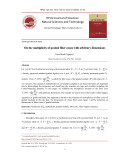
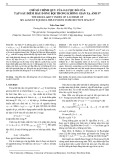
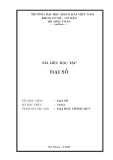

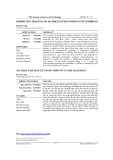
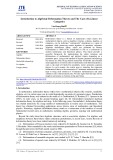
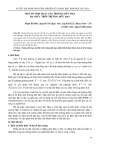
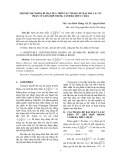
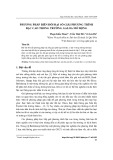










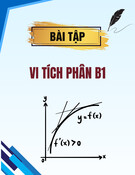



![Quyển ghi Xác suất và Thống kê [chuẩn nhất]](https://cdn.tailieu.vn/images/document/thumbnail/2025/20251030/anh26012006/135x160/68811762164229.jpg)
